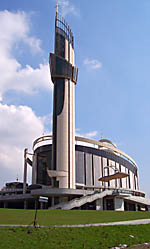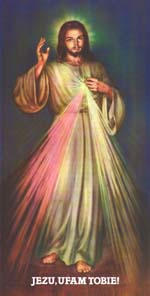The Shrine of Our Lord's Mercy in Krakow's Lagiewniki
District
By esthetic standards the 20th-century icon of the Lord’s
Grace hardly matches other Krakow’s twenty-odd wonder-making
sacred images
that are usually much older and mostly valuable as objects
of art. Yet devotion of thousands of believers has made the
painting sacrosanct. It depicts Christ as He appeared before
a visionary Polish nun, St. Faustyna Kowalska, one February
evening in 1931. The Lord instructed her to commission this
very likeness of Himself, complete with the caption which
reads in Polish: Jesus, I trust Thee. What is more, in the
series of appearances over the ensuing years He also
revealed to St. Faustyna His dogma of Divine Mercy. 
Krakow's Lagiewniki's Basilica of Divine Mercy
dominates the sanctuary.
At first the pious sister found little understanding among
her contemporaries who thought the days of miracles were
long past. The Church gave rather lukewarm support to St.
Faustyna and the revelations she had heard. Nonetheless,
with time the knowledge of them and the cult of the picture
have spread far.
Nowadays the icon adorns many a Catholic chapel throughout
the world. And pilgrims, both Polish and foreign, come daily
in their thousands to pray before the original picture at
the Krakow convent in the Lagiewniki area where 33-year-old
Sister Faustyna died in 1938 and where she is buried. Some
of the resultant faith cures are well documented.
The World's center of Divine Mercy
Now the 19th-century brick convent of the Sisters of God's
Mother of Mercy is part of the vast Sanctuary of Divine
Mercy (Sanktuarium Bozego Milosierdzia in Polish)
complete with a spacious main church, an array of chapels, a
viewing tower, a hostel and a modern pastoral lodge,
cafeterias, shops, parking lots, etc.
 Pilgrim's guide to Krakow
Pilgrim's guide to Krakow
On August 17, 2002 Pope John Paul II consecrated the
sanctuary's majestic 1,600-sq-m brand-new basilica. His
Holiness, previously the Krakow archbishop Karol Wojtyla, is
said to be once a driving force behind the worldwide
Catholic movement to worship the Lord’s Mercy with its
center in the Lagiewniki sanctuary. Every year some two
million pilgrims from all over the world visit the shrine.

The Lord's Mercy icon remains
in the heart of the
sanctuary,
i.e. the convent's chapel, where
St. Faustyna's relics are also to be found.
Regular Holy Masses in the Lagiewniki Sanctuary of Divine
Mercy
Every Sunday and on church holidays the faithful may hear
Holy Mass in the Shrine's spacious modern basilica at 9
a.m., 10:30 a.m., noon, 1:30 p.m., 3:20 p.m., and 6 p.m. On
weekdays and on Saturdays the service takes place at 9 a.m.,
10 a.m., 3:20 p.m., and 6 p.m.
Also, there are regular Holy Mass services in the convent's
old chapel with the relics of St. Faustyna. They take place
at 7 a.m., 8:30 a.m., noon (English Mass) and 7 p.m. on Sundays; and at 6:30 a.m. and 5 p.m. on
weekdays and Saturdays.
Every day there is a special prayer in the basilica in the
Hour of Mercy at 3 p.m. followed by the Chaplet of Divine
Mercy.
The Lagiewniki sanctuary's contact info
Postal address: Sanktuarium Bozego Milosierdzia, ul. Siostry
Faustyny 3, 30-608 Krakow, Poland.
Information desk's phone numbers: (+48) 122523311 or (+48)
122523333 (service available between 8:30 a.m. and 6 p.m. on
weekdays and from 10 a.m. to 5 p.m. on Sundays.
Sanctuary of Divine Mercy in Krakow's district of Lagiewniki,
how to get there.
The sanctuary is situated some four kilometers south of
Krakow's central Old Town historic district.
Taxi is the most convenient means of transport. The fare
from the center of Krakow to the Sanctuary of Divine Mercy
should not exceed an equivalent of six euro. Conversely, you
may take trams number 8 or number 19, get off at a stop
called Sanktuarium, cross the busy Zakopianska street (there
is an underpass), and walk some 400 meters up Siostry
Faustyny street.
Note:
Special
train service from Krakow Glowny central rail station,
called 'papal train, to the Lagiewniki Sanctuary of Divine
Mercy,
Wadowice - Pope John Paul II’s birthplace,
and the town of
Kalwaria Zebrzydowska famous for its Calvary sanctuary
is cancelled since September 1st, 2009. But a couple of
regular trains still link the above places every day. Krakow
Borek Falecki station is situated some 300 meters west of
the Sanctuary of Divine Mercy.
Staying
overnight at the Sanctuary of Divine Mercy in Krakow's
Lagiewniki
The nuns run a
hostel with modern amenities in a converted building of
their convent. Other lodging option available at the shrine
is a modern two-star hotel on the premises, called a
Pastoral Lodge (Dom Pielgrzyma).
Krakow churches
Krakow numerous churches are architectural gems, art
hoards, and spiritual hubs
Wawel Cathedral on the Wawel Hill
Poland's impressive national shrine dates from the 14th
century and shelters plenty of superb church art. The Sigismund Chapel is a masterpiece of the
Renaissance art and architecture. Giant Zygmunt bell of 1520 ranks with the world's largest. Most Polish kings are buried here together with the greatest
national heroes.
Basilica of the Virgin Mary's at the Grand
Square
Immense Gothic church, the city of Krakow's principal
temple since the 13th century, boasts the world's greatest Gothic sculpture among its many excellent works of art.
Huge stained-glass widows of the chancel date from the 14th
century.
Tyniec Abbey
Hilltop monastery-fortress dates from the 11th c.
Bielany Monastery
Magnificent 17th-century Baroque hermitage complex atop
the Silver Mountain hovers over Krakow.
St. Norbert's Convent
Vast fortified complex on the Vistula river is home to
Krakow’s once powerful Premonstratensian Sisters since the 12th
c.
Mogila Cistercian abbey of Krakow
A spiritual hub of the Krakow region since the 13th century.
Roman Catholic Church Sunday
Masses
|





